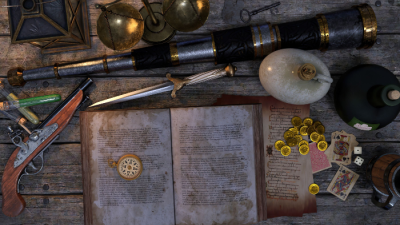Dragon’s Dogma 2 Vocation tier list

Dragon’s Dogma 2 has 10 classes for you to choose from. While a few are available from the start, you’ll have to unlock the others as you go. Choosing the proper vocation can make all the difference between having a good or bad time. It’s the heart of Dragon’s Dogma 2’s combat system and essentially serves as character classes that your main Pawn and player character can spec into.
Your vocation will determine everything—from how you fight and what gear you can equip to the level of difficulty posed when doing certain quests. Having a suitable class for every situation the game throws at you is essential. With so many choices, choice paralysis may set in, but fret not—our tier list will show what classes stand out from the rest.
Table of Contents
S-Tier
Sorcerer
There’s a reason why we rank the Sorcerer so highly in this list. That’s because it has near-unrivaled potential when taking out hostiles from afar. The High Levin spell and Quickspell will be your bread-and-butter ability. Who doesn’t love sending down several lightning strikes to zap a foe?
Once you’ve reached the endgame and unlocked Maelstrom and Meteoron from a quest (Sorcerer’s/Spellbound Appraisal grimoire quest), the Sorcerer class’ DPS skyrockets. Maelstrom creates a huge tornado that can wipe out everyone in its vicinity, while the Meteoron can rain down chunks of rocks from the sky.
Warfarer
The Warfarer is a highly versatile vocation that can learn spells and skills from any vocation. They can also use all sorts of weapons without restrictions, making them a perfect class if you always want to try something new. Their adaptability allows them to excel in various situations, making Warfarers a valuable asset in any party composition you put them in.
As we’ve said before, the Warfarer lets you equip any weapon and armor. You can even use all class abilities save for ultimate techniques. This is partly due to its Rearmament function, which allows you to activate class-specific skills and swap your weapons. The vocation lets you fine-tune your character to a degree.
That said, there are some caveats you should know about before you try being a Warfarer. For one, it unlocks relatively late in the campaign. You can only obtain it by accomplishing the New Liquer/Sotted Sage quest. Second, you must still level up the other classes to unlock their skills. But once you’ve put in all that effort, the Warfarer can offer a dynamic and engaging gameplay experience.
A-Tier
Thief
You won’t find any vocation better than the Thief regarding damage-dealing capabilities and survivability. You have the Skull Splitter as your main DPS, which causes you to spin and shred everything on your path. Since it also makes you jump into the air, you can hit an enemy’s weak spot multiple times to take a chunk out of their health bar. Meanwhile, Masterful Kill is another skill that deals a ton of damage if you press the prompt just before an enemy’s attack lands on you.
The Formless Feint skill is the Thief’s ultimate technique that, in our opinion, seals the deal. It comes from the Nameless Village, and while active, it acts as a permanent Shadowstep so you can avoid every kind of attack. The only catch is that using it will drain your stamina over time.
Magick Archer
Combine precise archery with magic, and you’ve got the Magick Archer. This vocation can be unlocked by doing the Put a Spring in Thy Step quest. Magick Archers have a plethora of spells capable of targeting single or multiple enemies. They also can revive fallen pawns, adding a strategic advantage to their arsenal and an invaluable asset.
Another reason why we put the Magick Archer in this tier is because of their ultimate technique, Martyr’s Bolt. While charging Martyr’s Bolt, your HP gets drained. The more HP you lose, the higher damage you’ll deal with it. It’s a risk-versus-reward type of skill, but it’s more than capable of downing a boss with a single cast. Always bring an Allhear Elixir or a Wakestone to counter the HP drains.
Mystic Spearhand
The Mystic Spearhand is a new vocation to the series. Think of it as a melee-based alternative to the Magick Archer. This vocation balanced ranged spells and melee attacks, making it versatile. You can alternate using the Duospear weapon and throwing spells to hurl objects and paralyze enemies.
Their damage output isn’t the best compared to the other vocations on this list, but it makes up for it by having high survivability. This is thanks to Mirour Vesture, a regular skill that creates an impenetrable barrier for you and your pawns. The barrier lasts for eight seconds, making everyone under it impervious to all types of damage. So, while the Mystic Spearhand’s damage pales compared to the Thief or Magick Archer, it’s still a vocation you should try out at least.
Mage
Mages support their allies through healing spells and defensive buffs, but that’s not all they’re good for. Beyond their support role, Mages can use offense and defense, making them a worthy addition to any party. Plus, once you’ve finished the Sorcerer’s/Spellbound Appraisal quest, you’ll obtain Celestial Paean—the best support skill in Dragon’s Dogma 2.
With that in mind, we recommend saving this vocation for your pawns instead. Your AI companions are more than enough to heal and buff your team, especially if it matches their specialization.
B-Tier
Warrior
As a no-nonsense melee DPS class, the Warrior remains a staple for most RPGs, and the same can be said for Dragon’s Dogma 2. The vocation uses devastating AoE abilities and wields two-handed weapons, so you know they can pack a punch. They can also draw in enemy aggro using Roar to make way for other pawns.
The Warrior is a consistent class; you can’t go wrong with it. However, the classes we mentioned above have the means to outshine it in multiple situations. The class compensates for its lack of defensive powers for high damage but can still struggle against enemies with high physical resistance.
Fighter
Fighters are touted as a party’s frontline tank. They can absorb damage with shields and parry attacks that would otherwise be fatal for other vocations. Since they have a straightforward playstyle, it’s a class that’s easy for anyone to pick up and play. However, once you’ve reached the game’s later stages, the Fighter’s already low DPS potential falls considerably.
C Tier
Trickster
Like the Mage, the Trickster is a support vocation that focuses on distracting enemies and buffing allies with the tricks up its sleeve—pun intended. Rather than doing straight healing, this class focuses on augmenting the rest of your party. We don’t like that the player character can only unlock its potential unless you’re highly confident with your pawn’s abilities. Another point that might feel like a caveat to most people is that you won’t be able to deal any damage with it. The best thing you can do to attack is to use your Effigial Incense to summon a simulacrum.
Archer
The Archer can hold on its own in combat. Its Tempest, Exploding, and Barrage Shot can obliterate towering enemies like Trolls. However, these skills don’t consistently do high damage once you’re in the late game. Meanwhile, other vocations can hit weak spots multiple times while you’re still fiddling with your aim. It’s not a class for everyone and requires substantial skill to be played effectively, and even then, the Archer struggles to match the DPS output of other vocations.















